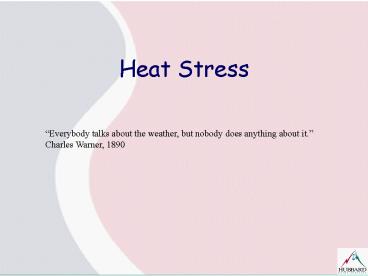Heat Stress - PowerPoint PPT Presentation
1 / 18
Title:
Heat Stress
Description:
Heat Stress 'Everybody talks about the weather, but nobody does ... Higher ketone levels at calving. Higher NEFA levels at calving. Heat Stress in Dairy Cows ... – PowerPoint PPT presentation
Number of Views:135
Avg rating:3.0/5.0
Title: Heat Stress
1
Heat Stress
Everybody talks about the weather, but nobody
does anything about it. Charles Warner, 1890
2
Heat Stress in Dairy Cows
- Indicators of Heat Stress
- Increased body temperature (gt102.5º F)
- Increased respiration rate (gt80 breaths/min)
- Increased water intake and sweating
- Reduced activity and more cows standing
- More crowding around the water tank
- Reduced feed intake (gt10-15)
- Reduced milk yield (10-20 or more)
3
Heat Stress in Dairy Cows
- Impacts of Heat Stress
- Milk production
- Reduced daily output
- Reduced lactation peaks
- Reduced milk component levels
- Higher SCC levels
4
Heat Stress in Dairy Cows
- Impacts of Heat Stress
- Reproduction
- Reduced estrous activity
- Reduced estrous duration
- Reduced heat detection
- Reduced follicular development
- Reduced oocyte quality
- Reduced semen quality
- Reduced conception rate
- Reduced pregnancy rate
- Multiple ovulations increased twinning
5
Heat Stress in Dairy Cows
- Impacts of Heat Stress
- Pregnancy/Early lactation
- Decreased uterine blood flow
- Increased embryonic death
- Reduced placental mass
- Reduced fetal tissue growth
- Reduced mammary tissue growth
- Early calvings
- Light, weak or dead calves
- Lower colostrum immunoglobulin (IgG)
- Lower colostrum protein, fat, and lactose
- Lower calf blood protein levels
6
Heat Stress in Dairy Cows
- Impacts of Heat Stress
- Feed intake/Digestion
- Reduced dry matter intake
- Increased feed sorting
- Increased feed refusals
- Reduced rumen contractions
- Reduced natural buffering capacity due to reduced
saliva production and increased carbon dioxide
expiration - Increased loss of minerals due to sweating,
panting, and urination - Increased metabolic disorders
7
Heat Stress in Dairy Cows
- Impacts of Heat Stress
- Cow health
- Suppressed immune function
- Increased mastitis incidence
- Increased retained placenta
- Higher ketone levels at calving
- Higher NEFA levels at calving
8
Heat Stress in Dairy Cows
- Strategies for minimizing heat stress
- Provide adequate drinking water.
- Provide shade.
- Reduce parlor walking distance.
- Reduce time in holding area.
- Improve ventilation.
- Add holding area/exit lane cooling.
- Cool close-up cows.
- Cool fresh/early lactation cows.
- Cool mid- and late-lactation cows.
9
Heat Stress in Dairy Cows
- Dietary Modifications
- Fiber Non-fiber carbohydrates
- Fiber can increase a cows heat load.
- Fiber is essential to rumen health.
- Target for 19 ADF, 30 NDF, and 21 forage NDF
using high quality forages - 8-12 on top screen of Penn State shaker box
- NFC levels lt 40
10
Heat Stress in Dairy Cows
- Dietary Modifications
- Fiber Non-fiber carbohydrates
- Try to avoid increasing the grain feeding
- Heat stressed cows at greater risk for acidosis
- Decreased buffering capacity saliva panting
- Decreased rumen contractions
- High grain diets during hot weather
- Decrease rumen pH
- Increase rumen ammonia and lactic acid
11
Heat Stress in Dairy Cows
- Dietary Modifications
- Fat supplementation
- Are energy dense have a low increment
- Will improve energy balance
based on 50 lbs of dry matter intake
12
Heat Stress in Dairy Cows
- Dietary Modifications
- Protein
- Try to keep less than 18
- Consider raising UIP slightly
- Excess nitrogen must be excreted from the body,
increasing workload of kidneys liver
13
Heat Stress in Dairy Cows
- Dietary Modifications
- Water
- Water needs increase significantly with heat
- Water acts as a heat sink
- Add water tanks/troughs in return lanes/pens
14
Heat Stress in Dairy Cows
- Dietary Modifications
- Feeding strategies
- Feed multiple times per day
- Feed at cooler times of the day
- Ration Guard to minimize heating in bunk
- Add water ??????
15
Heat Stress in Dairy Cows
- Dietary Modifications
- Minerals/Buffers
- Increase sodium levels
- Increase sodium levels to .55-.65
- Sodium bicarb or Sodium sesquicarbonate (.50-.70
lbs/day) - Offer free choice buffer
- Increase potassium levels
- Increase potassium levels to 1.4 1.9
- 1st choice (most expensive) is DCAD Plus (K
carbonate) this will help with overall positive
DCAD - 2nd choice is Dynamate (K sulfate/Mg sulfate)
- 3rd choice is Potassium chloride (Dyna K)
- Dynamate and KCL dont help with positive DCAD so
much
16
Heat Stress in Dairy Cows
- Dietary Modifications
- Minerals/Buffers
- Minimize excess chloride, if possible
- Chloride levels can go down to .25-.30 in heat
- If increasing Sod. Bicarb/sesquicarb levels,
consider dropping salt level to .15 lbs/head/day - Increase magnesium level if increasing potassium
- Maintain KMg ratio of 4-51
- Magnesium levels of .30-.40
- Magnesium oxide, magnesium sulfate, or Dynamate
- Consider free-choice salt/bicarb
17
Heat Stress in Dairy Cows
- Dietary Modifications
- Other additives
- Yeast (Ridley Yeast Culture Concentrate)
- Stabilize rumen environment
- Increase forage digestion dry matter intake
- Complexed Zinc Biotin
- For hoof health/somatic cell count
18
Heat Stress in Dairy Cows
- What to watch for
- TMR particle size and sorting
- Cud chewing
- Manure consistency
- Fat/Protein inversions































